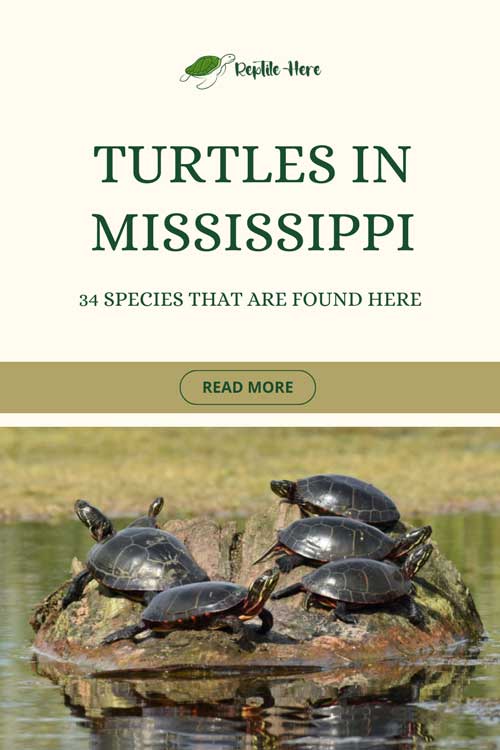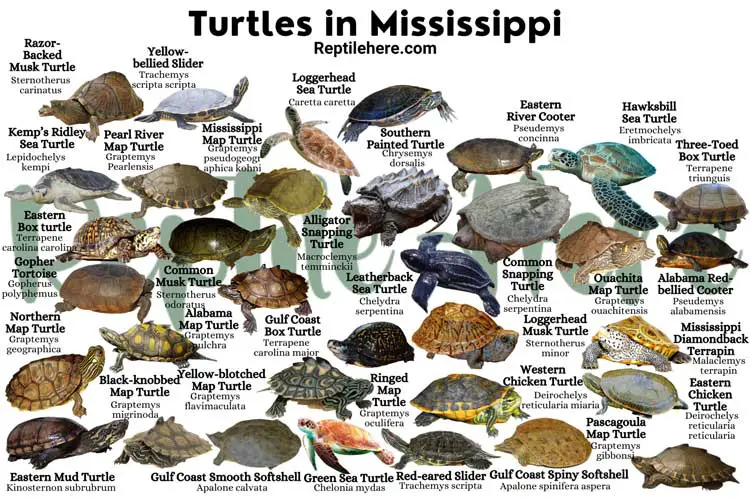Turtles in Mississippi – 34 Species That are Found Here
Mississippi is home to 34 species of turtles. Aquatic and semi-aquatic turtles make up the largest group of these species and include the snapping turtles, smooth softshells, spiny softshells, Cooters, painted turtles, map turtles, mud and musk turtles, and diamondback terrapins.
The state is also inhabited by terrestrial or box turtle species which include the eastern box turtle and gulf coast box turtle.
A gopher tortoise is also found in this region of the United States.
On top of all this, Mississippi hosts up to 5 sea turtle species namely green sea, kemp ridley, leatherback, loggerhead, and hawksbill sea turtles.
In the following guide, we take you through a rundown of all the species of turtles found in Mississippi. For each turtle, we have covered key details such as physical appearance, size, lifespan, diet, habitat, conservation status, and more.
34 Types Of Turtles In Mississippi
Contents
1. Alligator Snapping Turtle
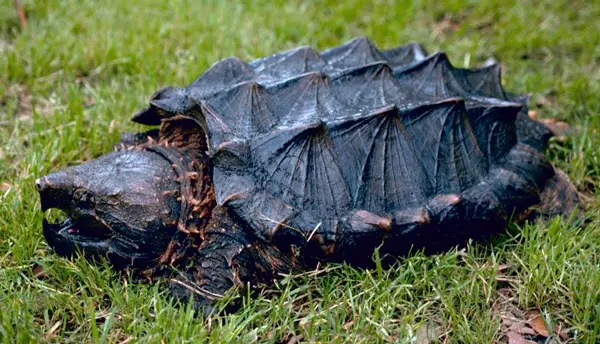
- Scientific name: Macroclemys temminckii
- Common name: Alligator snapping turtle, Snapping turtle
- Family: Chelydridae
- Size: 15 to 26 inches
- Lifespan: 80 to 120 years
- Conservation status: Vulnerable
The alligator snapping turtle is the largest freshwater turtle in Mississippi. This species is large than the common snapping turtle. An adult alligator snapping turtle weighs 15 to 20 inches long.
An alligator turtle is characterized by a long, tough shell with trigonal ridges that resemble the back of an alligator (hence the name alligator turtle). Shell coloring can be black, olive, or brown. Though some people believe that the green tips on the shell ridges are natural, they’re simply algae.
These alligator turtles also prefer living in deeper waters of rivers, canals, lakes, and swamps in Mississippi.
As omnivorous species, they hunt their prey (but not actively). They have a unique way of hunting where they lie at the bottom of the water body and open their mouth to show their pink work-like appendage to lure their prey. And when the prey gets close enough, the turtle ambushes it!
Another interesting fact about this turtle is its powerful jaws which can bite with a force of up to 1000lbs!
This makes them extremely dangerous turtles and should NEVER be handled in the wild! Mind you, they have injured even the most experienced herpetologists with their bites.
2. Common Snapping Turtle
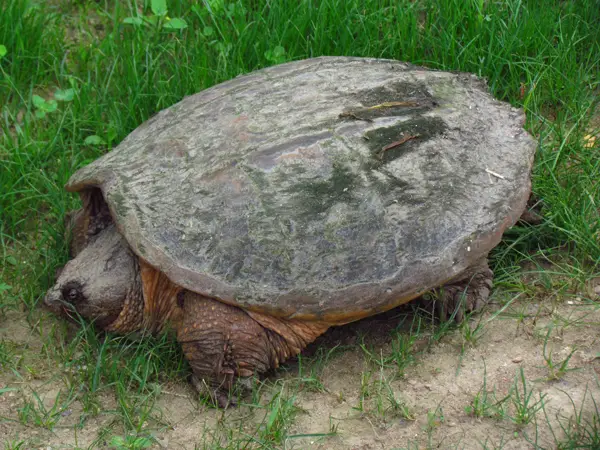
- Scientific name: Chelydra serpentina
- Common name: Snapping Turtle
- Family: Chelydridae
- Size: 8 to 18 1/2 inches
- Lifespan: 30 to 50 years or more
- Conservation status: Least Concern
Common snapping turtles are widespread throughout Mississippi. An average adult is pretty large and has a shell length of 18½ inches long.
This species has a chunky head, a long tail, and large webbed feet. The shell color is black or olive and has no distinct pattern. These Mississippi snapping turtles are known for their powerful jaws—they’re so strong that these turtles eat other turtles!
You’ll find them in waterbodies with muddy bottoms. Examples include marshes, ponds, lakes, rivers, and even shallow streams. They generally prefer waters with aquatic vegetation in plenty and foods such as fish, frogs, birds, etc.
These Mississippi turtles generally show docile behavior but can get quite aggressive if taken out of water. The best way to calm it is to take it back to the waters, where it feels safe.
3. Gulf Coast Smooth Softshell
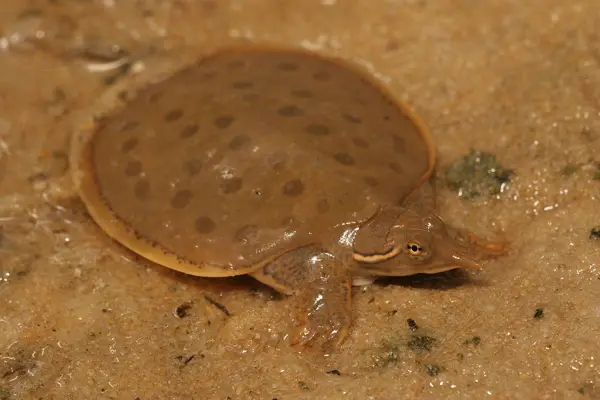
- Scientific name: Apalone calvata
- Common name: Gulf Coast Smooth Shell
- Family: Trionychidae
- Size: 6.5 to 14 inches (females), 4.5 to 10.5 inches (males)
- Lifespan: 25+ years
- Conservation status: Least Concern
This turtle is a sub-species of smooth softshell turtle and is found in the Mississippi Panhandle area. The turtle is fully aquatic and inhabits major river systems in this region as well as parts of Louisiana.
Though most people believe these turtles are slow-moving, they’re the fastest in Mississippi! This enables them to outrun their predators given that their soft shells don’t offer much protection.
Shell color of this turtle ranges from olive to dark brown. The upper part of its shell features dark markings (with female markings appearing in a blotchier pattern than the males’)
The shell of these turtles also appears rounder and flatter, just like other softshell species.
These turtles like inhabiting waterbodies like rivers and streams in Mississippi that provide an abundance of mud or sand at the bottom. They can also be found in stagnant waterbodies.
Midland smooth softshell turtles are omnivorous and their diet revolves around aquatic vegetation and insects. However, they prefer meat more than plant matter and will mainly eat snails, insects, and fish.
4. Gulf Coast Spiny Softshell
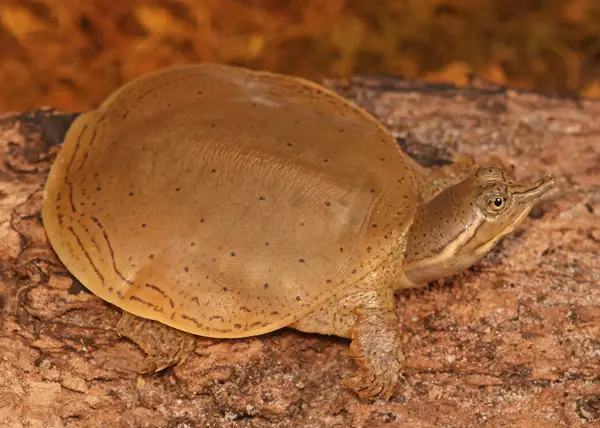
- Scientific name: Apalone spinifera aspera
- Common name: Spiny softshell turtle
- Family: Trionychidae
- Size: 7 to 19 inches (females), 5 to 9.5 inches (males)
- Lifespan: 20 to 50 years
- Conservation status: Least Concern
The Gulf Coast Spiny Softshell is a subspecies of the spiny softshell turtle and is found in small pockets across the state of Mississippi.
It is characterized by a leathery pancake-like shell marked with small spines. It has a series of black bars that run around the rim of its shells, with ring-like markings resting on its upper shell.
The upper shell color for this Mississippi spiny softshell turtle ranges from brown to tan. Just like other softshell turtles, this species also has a snorkel-like snout.
Female spiny softshell turtles are usually larger than males. The young ones feature well-defined round spots that are easily visible on the shell (though these spots become invisible as they transition to adulthood).
Spiny softshell turtles in Mississippi tend to eat anything they find in the waters including crayfish, insects, small fish, and so on. They hunt by burying themselves in the mud or sand while keeping their head uncovered to grab food as it swims by.
These turtles are also able to breathe underwater by taking in oxygen through their throat skin. This is a useful adaptation given that they don’t spend a lot of time out of water.
Other adaptations of these turtles include webbed feed, long claws, and extremely flat shells that enable them to quickly swim away from predators and burry in the muddy bottom of the waters they reside in.
5. Alabama Map Turtle
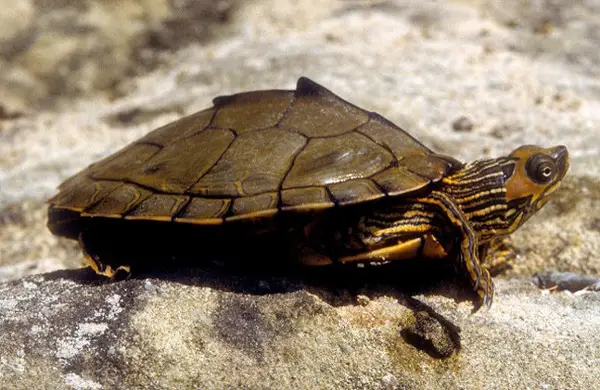
- Scientific name: Graptemys pulchra
- Common name: Alabama Map Turtle, Sawback
- Family: Emydidae
- Size: 3.5 to 5.25 inches (males), 7 to 11.5 inches (females)
- Lifespan: 50+ years
- Conservation status: Near threatened
This species of turtle is ONLY found in Mobile Bay Drainage System in Alabama, hence the name Alabama map turtle.
It is easily identifiable by a spiny black line that runs down the middle of its shell. They get the name “map” from the map-like markings on their shell back.
The Mississippi turtles are medium-sized (though males are smaller than females) and are pretty shy. They’re known to slip into the water in case of any disturbance or danger. Their carapace is usually brown with faint yellow, orange, or green markings.
Juveniles are usually bright-colored, but their coloration tends to fade over time. The spiny back of these turtles also tends to wear as they age, especially for adult females.
These Mississippi map turtles are omnivorous, and their diet mainly consists of aquatic plants. However, they also feed on insects, small fish, tadpoles, and even worms.
Alabama map turtle is mainly found in shallow and highly vegetated waters in Mississippi, including ponds and rivers. They can also be found in fast-moving creeks featuring rocky bottoms.
6. Black-knobbed Map Turtle
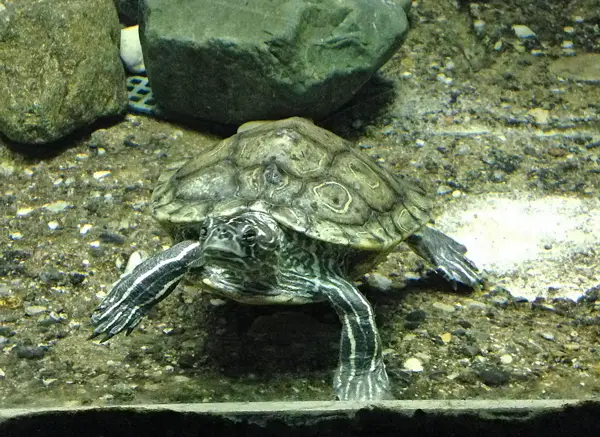
- Scientific name: Graptemys migrinoda
- Common name: Black-knobbed Sawback
- Family: Emydidae
- Size: 3 to 5 inches (males), 8 to 10 inches (females)
- Lifespan: 30 to 50 years
- Conservation status: Least Concern
The black-knobbed map turtle is also found in Mississippi. This medium-sized aquatic turtle species is small to medium-sized and is easily identifiable by black knobs/spines along the middle of its back.
In terms of coloration, this species usually has a dark olive upper shell and a pattern that resembles a map, making it a subspecies of map turtles.
And the lower side of its shell features yellow and dark colored patterns. Its skin is usually black with yellow-colored stripes.
Like the other map turtle species, the black-knobbed map turtle prefers living in Mississippi in slow-moving or stagnant lakes, ponds, or streams with a lot of aquatic vegetation.
These map turtles are omnivorous and feed on meat, insects, vegetables, fruits, aquatic vegetation, etc.
7. Mississippi Map Turtle
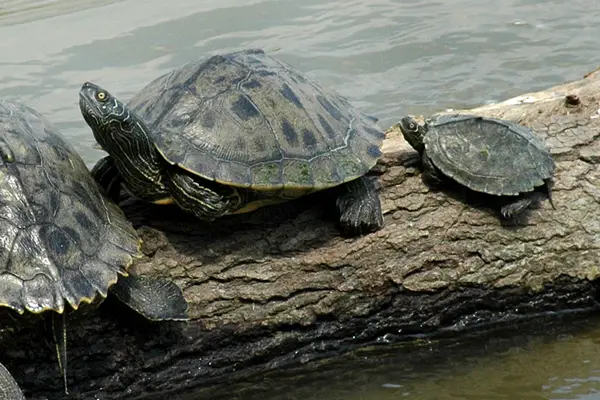
- Scientific name: Graptemys pseudogeographica kohni
- Common name: Mississippi Map Turtle, False Map Turtle
- Family: Emydidae
- Size: 3 to 10 inches
- Lifespan: 30 to 50 years
- Conservation status: Least Concern
The False map turtle is another turtle species found in Mississippi. This turtle’s preferred habitat in Mississippi includes rivers, streams, and oxbow lakes of the Missouri and Mississippi river systems.
It is an excellent swimmer and prefers moderate currents and deep waters.
Its upper shell coloring ranges from olive to dark brown, with light-colored lines on its limbs. It also features a line behind its eye that forms a backward “L” shape. The map pattern on its carapace tends to fade as the turtle ages.
Since this map turtle of Mississippi is omnivorous, it feeds on aquatic insects and animals as well as vegetation. It is fond of river snails and crustaceans. Don’t forget it has strong jaws and can give a nasty bite!
Like most of the other aquatic turtles of Mississippi, this map turtle spends most of its waking hours sunning.
The map turtle is quite shy and quietly and swiftly slides into the water at the slightest signs of disturbance. It likes spending most of its time in water and is most active in climate conditions of over 85 degrees Fahrenheit.
8. Northern Map Turtle

- Scientific name: Graptemys geographica
- Common name: Northern Map Turtle, Common Map Turtle
- Family: Emydidae
- Size: 3 to 10 inches
- Lifespan: 30 to 50 years
- Conservation status: Least Concern
The common map turtle is one of the map species that inhabit Mississippi. To be more specie, this freshwater turtle resides in the rivers and lakes of Mississippi.
It prefers large waterbodies with debris. These offer the perfect spots for basking while the water bodies enable the aquatic animal to spend its hibernation periods in winter completely submerged.
Like other map turtles, this common map turtle gets its name from the map-like pattern on its shell. Its shell is typically darker in color and ranges from brown to black. The map pattern has a lighter coloration.
The common map turtle of Mississippi is mainly carnivorous and feeds on mollusks such as clams and snails. It will also eat crayfish and insects. And when animal matter gets scarce, it will turn to plant matter.
Note that it may be difficult to spot a common map turtle in the wild in Mississippi. Although active during the day, these turtles are quite shy and will quickly retreat to the waters at the slightest disturbance.
9. Ouachita Map Turtle
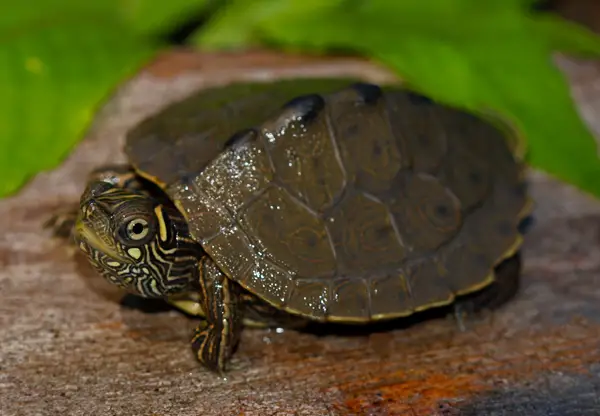
- Scientific name: Graptemys ouachitensis
- Common name: Ouachita Map Turtle, Map Turtle
- Family: Emydidae
- Size: 3 to 5 inches (males), 8 to 10 inches (females)
- Lifespan: 30 to 50 years
- Conservation status: Least Concern
The Ouachita map turtle lives in the northern part of Mississippi and is regarded as one of the less popular map turtle species. The turtle makes an excellent choice of pet for many people since it’s easy to care for.
As for its name, this species is named after the river where it was discovered—Ouachita!
Ouachita turtle is medium to large in terms of size. The average adult female is 3-5 inches long while the male is 8 to 10 inches long. It features thin, yellowing lines that form a web on the turtle’s shell (similar to a contour elevation map).
Moreover, the turtle has brown to olive coloring, with a light spot under both eyes.
The easiest way to identify this Mississippi turtle from other map turtle subspecies is by checking the dots on its face. They usually have 3 prominent spots—under the jawline, under the eye, and behind the eye.
Note that this turtle prefers living in stagnant or slow-moving waters, including ponds, lakes, and streams. of Mississippi It also prefers waters with plenty of vegetation. This species is omnivorous and eats meat, insects, vegetables, fruits, and aquatic vegetation, to name but a few.
10. Pascagoula Map Turtle
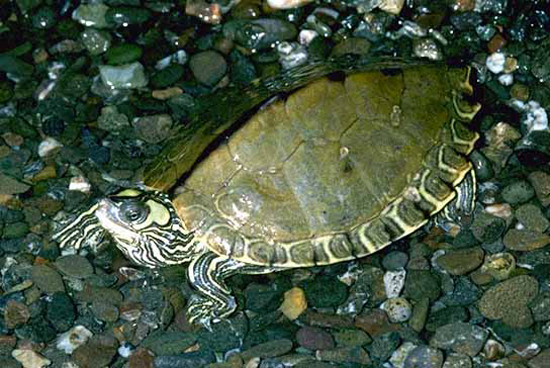
- Scientific name: Graptemys gibbonsi
- Common name: Pascagoula Map Turtle, Pascagoula Sawback
- Family: Emydidae
- Size: 5 to 11.5 inches
- Lifespan: 30 to 50 years
- Conservation status: Endangered
This map turtle is native to the Pascagoula River, situated in Mississippi’s southeastern regions. it gets its name from Whit Gibbons, an American herpetologist.
Due to its restricted habitat, this turtle is classified as endangered and is under special monitoring by the relevant authorities in Mississippi.
The Pascagoula is identified by a brown to olive shell with protruding keels. It also features yellow stripe markings around its scutes, at the edge of the shell. Both its head and skin are olive with yellowish spots and stripes.
Like the other species of map turtles, this Pascagoula map turtle in Mississippi is omnivorous. It mostly feeds on insects, crustaceans, and aquatic plants.
11. Yellow-blotched Map Turtle
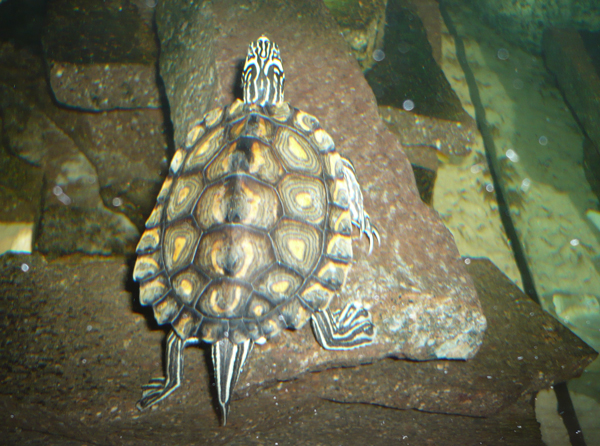
- Scientific name: Graptemys flavimaculata
- Common name: Yellow-blotched Sawback
- Family: Emydidae
- Size: 3.5 to 7.5 inches
- Lifespan: 30 to 50 years
- Conservation status: Endangered
Just like the Pascagoula Map Turtle above, this Yellow-blotched Map Turtle is found in Mississippi’s Pascagoula River (though it has also been observed in the Escatawpa river).
A Mississippi Yellow-blotched Map Turtle is identified by a green to olive upper shell, with yellow scutes at the center of most of its scutes.
It has a central ridge of prominent keels extending from the shell spine. Note that the central keel in this species is the largest that has even been observed in all map turtle species.
Like the other species of map turtles, this Pascagoula map turtle in Mississippi is omnivorous. It mostly feeds on insects, crustaceans, and aquatic plants.
Don’t forget that this Mississippi turtle is labeled as an endangered species in the US and is under special monitoring.
12. Pearl River Map Turtle
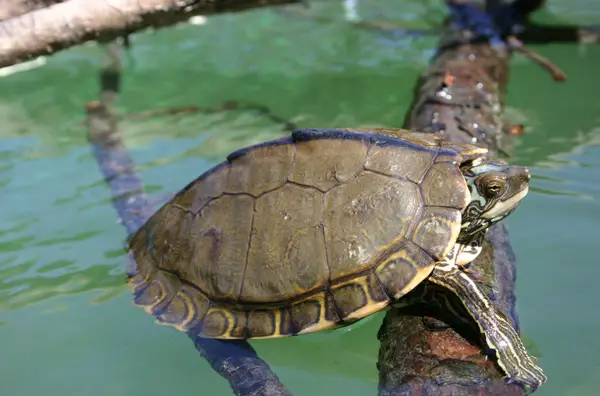
- Scientific name: Graptemys Pearlensis
- Common name: Pearl River Map Turtle
- Family: Emydidae
- Size: 3 to 5 inches (males), 8 to 10 inches (females)
- Lifespan: 30 to 50 years
- Conservation status: Endangered
The Pearl River Map Turtle is a rare sub-species native to Pearl River system in Louisiana and Mississippi.
Its upper shell is olive green and features fluted edges with yellow markings. The female usually has a larger head and a flattened, wide beak for crushing food.
Note that it is usually a challenge to tell apart this turtle in Mississippi from some of its close map turtle cousins.
Like the other map turtles, the females are usually larger than the males.
Pearl River Map Turtles in Mississippi are omnivorous and mainly feed on crustacean invertebrates, small fish, and aquatic plants.
Unfortunately, this turtle species native to the Southern United States is under threat in Mississippi from water pollution and has been labeled as endangered species due to its declining population.
13. Ringed Map Turtle
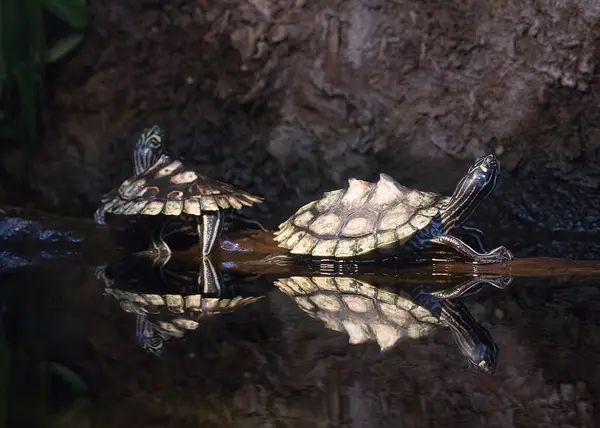
- Scientific name: Graptemys oculifera
- Common name: Ringed Map Turtle, Ringed Sawback
- Family: Emydidae
- Size: 3 to 5 inches (males), 8 to 10 inches (females)
- Lifespan: 30 to 50 years
- Conservation status: Vulnerable
This map turtle also shares a range with the Pearl River Map Turtles and is found in Pearl River system in Louisiana and Mississippi states.
In the state of Mississippi, this turtle is mainly confined to several eastern counties near Pearl River.
You can easily identify a ring map turtle by looking at its shell. it features prominent light circles on a dark shell background—this is where it gets the name “Ringed” turtle.
The shell color ranges from green to yellowish, with some sharp peaks situated down the center. And yes, their shells also feature jagged, saw-tooth edges.
This ringed map turtle in Mississippi is omnivorous and loves eating crustaceans, mollusks, and aquatic vegetation. it prefers living in moving waters such as rivers.
14. Eastern Mud turtle
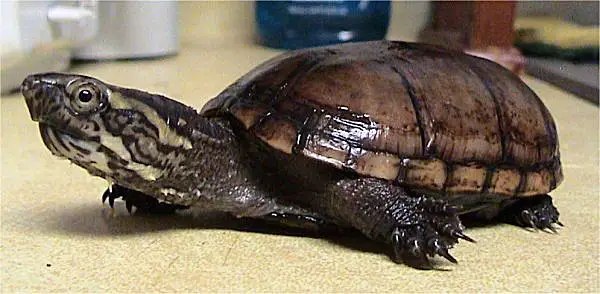
- Scientific name: Kinosternon subrubrum
- Common name: Eastern Mud Turtle, Mud Turtle
- Family: Kinosternidae
- Size: 3 to 5 inches
- Lifespan: 50 years
- Conservation status: Least Concern
The Eastern Mud turtle in Mississippi is found in shallow waters including ditches, marshes, wet meadows, and swamps.
This smaller aquatic turtle species is characterized by a smooth and unmarked shell. Yes, it has an incredible plain look, with its upper shell lacking any patterns. The carapace color ranges from dark yellow to black.
The lower side of the shell is also pretty plain, though it usually appears lighter on the upper part. The key distinction of this mud turtle is the stripes on its head which can be white or yellow in color.
One particular feature that sets this turtle apart from others and makes it easily identifiable is the hinges on its lower shell which form a “K” shape when viewed from the sides.
Just as its name suggests, this turtle lives in water bodies with a soft muddy, or sandy bottom. Thus, they can be found in marshes, swamps, and rivers in Mississippi.
Since the Mississippi eastern mud turtle is omnivorous, it eats meat, fish, snails, insects, and aquatic vegetation as well as plant matter on land.
Unlike other turtles, eastern mud turtles do not hibernate in the cold winter months. Instead, it does the opposite—it becomes dormant in the hot months of summer (this is known as aestivation).
15. Common Musk Turtle
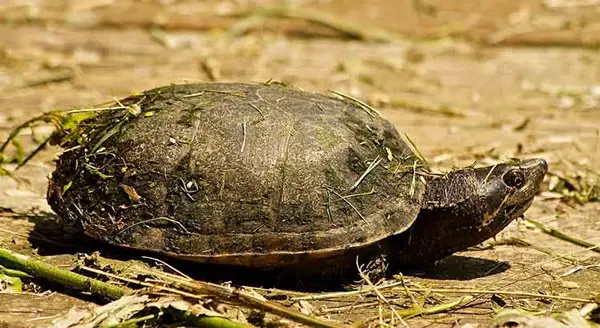
- Scientific name: Sternotherus odoratus
- Common name: Common Musk Turtle, Eastern Musk Turtle, Musk Turtle, Stinkpot
- Family: Kinosternidae
- Size: 2 to 4.5 inches
- Lifespan: 30 to 50 years
- Conservation status: Least Concern
The Common Musk Turtle is another aquatic turtle found in Mississippi’s slow-moving and sluggish streams as well as still water bodies. The turtle usually prefers areas with dark crevices, where it can easily hide. It also prefers lots of plant matter to burrow in and hide.
An average adult eastern musk turtle is quite small (2 to 4.5 inches long). It has a pretty plain appearance with highly consistent colors. Both the shell and skin usually share the same color and can range from dark brown to black.
The turtle shell has one unique feature—a ridge traversing its entire shell length. Besides, it has another distinctive feature: two light-colored stripes on its head.
Common musk turtles of Mississippi are herbivorous and will eat small aquatic or semi-aquatic animals, carrion, and aquatic vegetation. They will also feed on any other vegetation on land.
When it feels threatened, this musk turtle species emits a foul odor (a musky odor, hence its name). This scent can be detected in water or on land. It can also easily waft through the air to its predators.
Also, these Mississippi turtles are good at climbing trees! This great capability enables them to go high up tree branches to find a safe resting place and avoid predators.
16. Loggerhead Musk Turtle
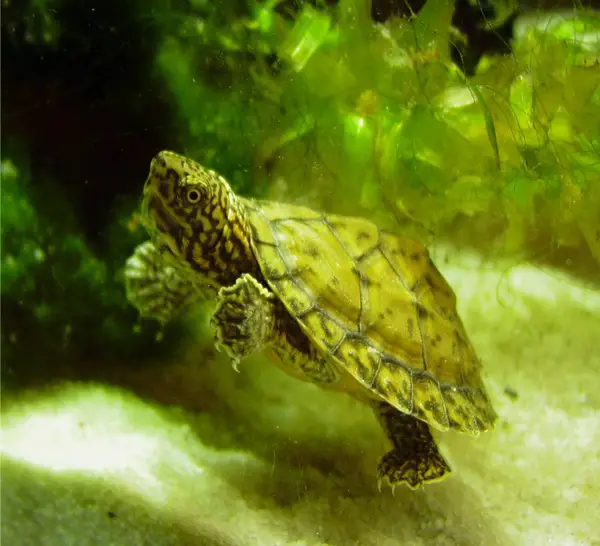
- Scientific name: Sternotherus minor
- Common name: Stripe head or loggerhead turtle
- Family: Kinosternidae
- Size: 3 to 4 inches
- Lifespan: 20 to 40 years
- Conservation status: Least Concern
The loggerhead musk turtle is the most recognizable of all the musk turtles in Mississippi. It has a large head and a beak-like mouth that easily set it apart from many other species of turtles.
These turtles are among the smallest of the species in the US, with the adult hitting a maximum length of 3 to 4 inches.
Also, the Mississippi loggerhead turtle features quite pronounced scutes in the middle of its shell which become less and less visible as it ages. Their carapace is usually light brown with a small streak of black. And their lower shell side is light brown or yellow. The skin color is black, with light brown lines.
As for the habitat, these Mississippi turtles prefer streams and springs with muddy bottoms, where they can comfortably and safely rest or lay eggs.
Loggerhead musk turtles are mainly carnivorous and their diet consists of fish, snails, and mollusks. When approached by predators, these turtles will also produce a foul smell.
17. Razor-backed Musk Turtle
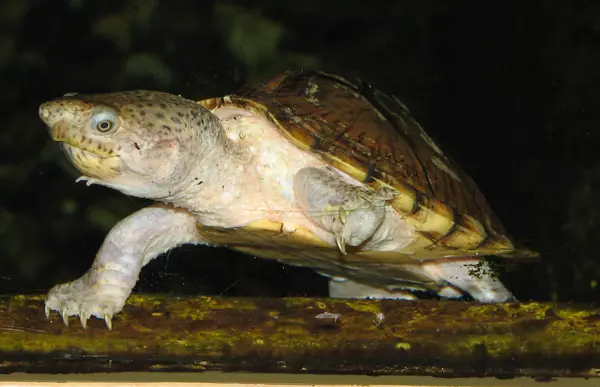
- Scientific name: Sternotherus carinatus
- Common name: Musk turtle, stinkpot
- Family: Kinosternidae
- Size: 5 to 6 inches
- Lifespan: 40 to 50 years
- Conservation status: Least Concern
The Mississippi razor-backed must turtle is identified by the keels on its back. In other words, its carapace is shaped like a tent that comes to a point along its spine and then slopes down on its sides.
Just like the other must turtles, this species is also pretty small and the average adult hits 5-6 inches in length. Their shell color ranges from light grey to olive, brown, and black. Skin color can be olive or dark brown, though the exact color differs from individual to individual.
These Mississippi turtles usually have long necks and large heads which usually have bright colors and turn gray with dark spots as they age.
This razor-back musk turtle prefers living in water almost entirely and will only leave the waters to bask or when it’s time to lay eggs. The species live in deep waters of oxbow lakes and river swamps. They also prefer living in slow-current large streams.
Diet-wise, the Mississippi razor-back musk turtle is mainly carnivorous and is fond of mollusks, snails, and fish.
18. Alabama Red-bellied Cooter
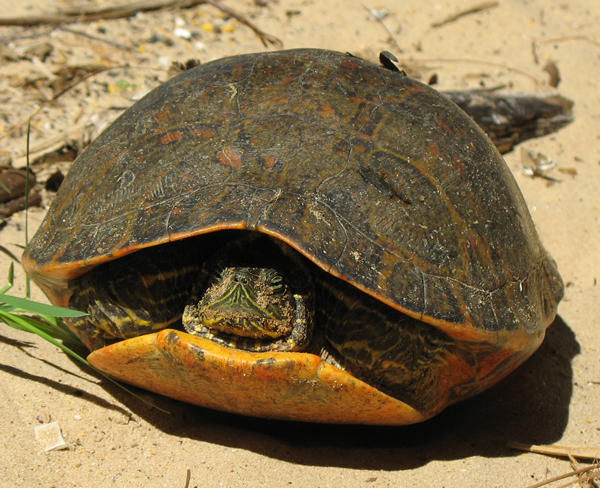
- Scientific name: Pseudemys alabamensis
- Common name: Alabama red-bellied turtle, Red-belly, Cooter
- Family: Emydidae
- Size: 8 to 12 inches
- Lifespan: 40 to 60 years
- Conservation status: Not Threatened
Alabama red-bellied Cooter lives in the fresh, shallow waterbodies of Mississippi. However, it’s not uncommon to come across one in slightly brackish waters.
These turtles are average-sized compared to most species and can reach between 8 and 12 inches in length.
The Mississippi redbelly scooter usually has a dark brown shell color, with some orange or red coloring on its edges. The lower side of the shell is usually red or orange. The turtle’s skin is usually black or dark brown and is covered by orange or yellow stripes.
Young Alabama red-bellied turtles have more intense and bright coloring, but it fades as they age.
These Mississippi turtles are, mainly herbivorous and fed on aquatic plants, algae, and land vegetation (they feed on this when basking or nesting). Mind you, this turtle is much easier to find when it’s foraging.
Alabama redbelly turtles are quite nervous and like basking on logs in the sun. They quickly retreat back into the water if they feel threatened or disturbed.
19. Eastern River Cooter
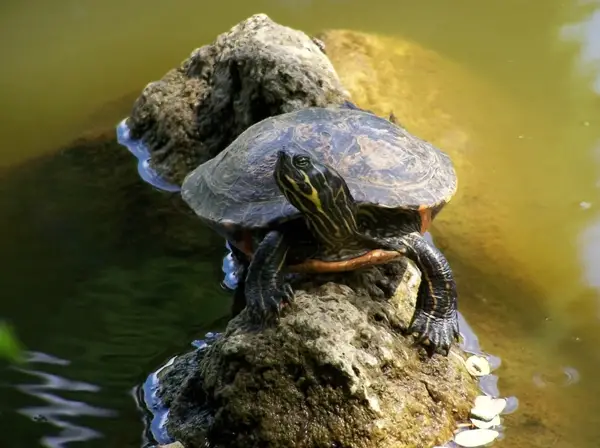
- Scientific name: Pseudemys concinna
- Common name: River Cooter
- Family: Emydidae
- Size: 8 to 12 inches
- Lifespan: 20 to 40 years
- Conservation status: Least Concern
Eastern River Cooter turtles are also inhabitants of Mississippi. They’re known to be solitary creatures and often like basking alone in the sun. However, they can be sometimes observed sharing habitat with painted turtles and red-eared sliders.
They’re distinguishable by their brown to olive or dark-green outer shell and lighter c-shaped, concentric markings in their scutes. Their skin can be olive or olive-brown in color, with numerous yellow lines.
Most of these turtle adults are around 8 to 12 inches in size, though it’s not rare to come across females with a bigger size—up to 15 inches.
These turtles are pretty fast both on land and in water. They’re found in various freshwater bodies including lakes, ponds, and rivers in Mississippi. They’re also found in brackish water.
Their diet is primarily herbivorous and mainly consists of various forms of aquatic vegetation and land plant matter, including fruits and vegetables. They’re however known to occasionally feed on insects and snails.
20. Mississippi Diamondback Terrapin
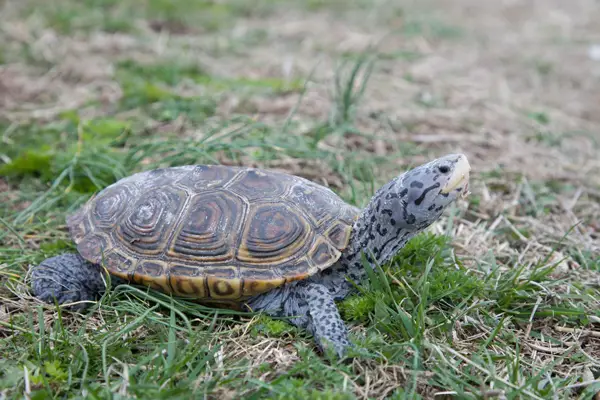
- Scientific name: Malaclemys terrapin
- Common name: Diamondback Terrapin, Mississippi Diamondback Terrapin
- Family: Emydidae
- Size: 4 to 6 inches (males), 5 to 8 inches (females)
- Lifespan: 25 to 35 years
- Conservation status: Vulnerable
The Mississippi diamondback terrapin is the only freshwater species in Mississippi that can adapt to saltwater as well. Their shells have a raised diamond shape, hence the name diamondback. The term “terrapin” simply means little turtle.
A typical diamondback terrapin in Mississippi has black or brown carapace and yellow lower shell that may sometimes feature dark-colored patterns. The turtle’s skin is usually grey-white with multiple small black spots.
Female diamondback terrapins are usually bigger than their male counterparts.
These turtles are highly timid and can easily get stressed when in captivity. They’re pretty docile and can be handled. However, they’re known to bite as a way of defending themselves if they feel threatened.
Diamondback terrapins can be found along the coast in tidal flats, salt marshes, barrier beaches, and brackish streams in Mississippi. They can also stay in full-strength saltwater for longer periods of time.
The terrapins are largely carnivorous and feed on crustaceans, fish, crabs, shrimps, marine snails, marine worms, mollusks, mussels, clams, and barnacles. However, they also tend to occasionally ingest small amounts of plant matter.
21. Eastern Chicken Turtle
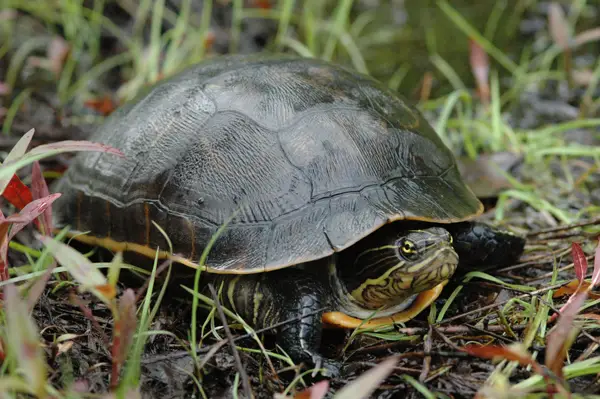
- Scientific name: Deirochelys reticularia reticularia
- Common name: Eastern Chicken Turtle
- Family: Emydidae
- Size: 5 to 10 inches
- Lifespan: 15 to 30 years
- Conservation status: Least Concern
Eastern chicken turtle is a sub-species of chicken turtle and resides in Mississippi state. it has an oval-shaped shell that’s dark brown or black in color. On top of this, its shell bears a relatively subtle pattern usually yellow in color.
The lower side of its shell is yellowish and the skin is dark colored and covered with yellow stripes.
Eastern chicken turtles in Mississippi can be found in canals, marshes, cypress, ponds, and other waterbodies that are still or sluggish. It is also frequently found in sand hills.
For the diet part, chicken turtles are omnivorous and like eating meat, fish, snails, insects, aquatic vegetation, and land plant matter such as fruits and veggies.
An interesting fact: Chicken turtles are so named because of their meat taste, which was a popular delicacy back in the 1970s!
Also read: Different Types Of Turtles Found in the United States
22. Western Chicken Turtle
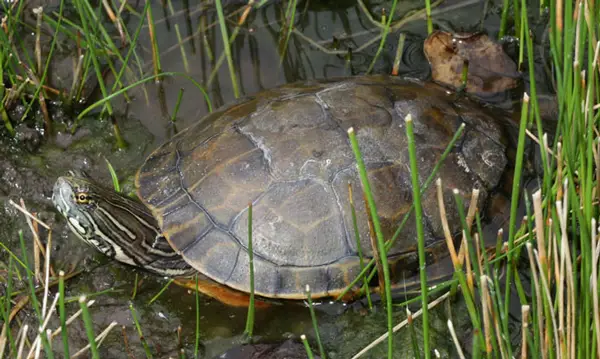
- Scientific name: Deirochelys reticularia miaria
- Common name: Western Chicken Turtle
- Family: Emydidae
- Size: 5 to 10 inches
- Lifespan: 15 to 30 years
- Conservation status: Least Concern
Western chicken turtle is another subspecies of chicken turtle species, native to the Mississippi state.
This species of turtle is regarded as the most social turtle species you’ll find in Mississippi! They’re known to bask or swim in groups and rarely live or travel alone.
The easiest way to observe them is when they’re basking, since most of their activities, including reproduction and feeding, happen underwater.
Chicken turtle shells are egg-shaped (oval) compared to other turtles and are black or dark brown in color. They also feature subtle yellow patterns. The lower side of the shell is usually yellow and the skin is dark and covered with yellow stripes.
Chicken turtles in Mississippi prefer living in still water areas such as ponds, marshes, and ditches in Mississippi. However, it is also easy to spot them on land when they’re foraging for food or basking in the sun.
For the diet part, chicken turtles are omnivorous and like eating meat, fish, snails, insects, aquatic vegetation, and land plant matter such as fruits and veggies.
An interesting fact: Chicken turtles are so named because of their meat taste, which was a popular delicacy back in the 1970s!
23. Southern Painted Turtle
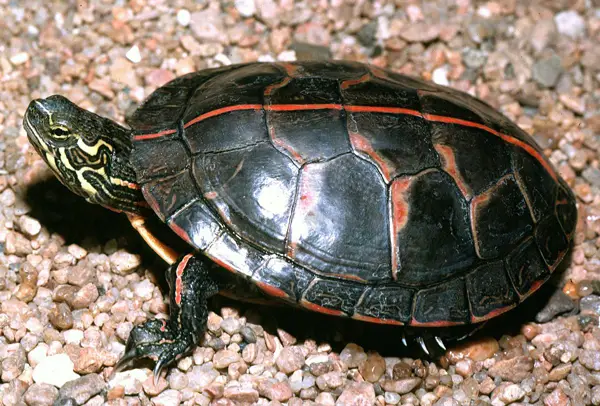
- Scientific name: Chrysemys dorsalis
- Common name: Painted Turtle
- Family: Emydidae
- Size: 4 to 6 inches
- Lifespan: 30 to 50 years
- Conservation status: Least Concern
The Southern painted turtle is a sub-species of painted turtle and the smallest of the painted turtle species in Mississippi. It prefers living in shallow water habits such as on edges of lakes and streams.
The average adult size ranges from 4 to 5 inches and is characterized by a distinctive orange or red stripe running down the back of its shell. They also feature a plain, pale-yellow skin belly (plastron) that’s sometimes lightly spotted.
Baby southern painted turtles tend to eat more meat and less vegetation. And as they grow up, they concentrate more on vegetation and less on animal matter.
Nonetheless, these turtles are omnivorous, just like other species. Some of the most common foods for this species include algae, duckweed, dragonfly larvae, and young crayfish.
Most folks like keeping these turtles as a pet due to their small size and unique color patterns on their shells. Not to forget they can live for quite a long time—up to 50 years—and most pet owners end up releasing them back into the wild in Mississippi.
24. Red-eared Slider
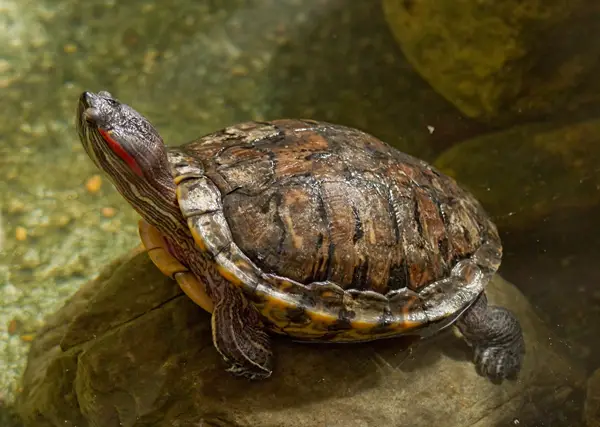
- Scientific name: Trachemys scripta
- Common name: Red-eared Slider, Red-eared Terrapin
- Family: Emydidae
- Size: 7 to 11 inches
- Lifespan: 30 to 40 years
- Conservation status: Least Concern
The red-eared slider is a subspecies of pond sliders and a native species of Mississippi. It is a semi-aquatic turtle and prefers living in marshes, ponds, lakes, and creeks.
A red-eared slider gets its name from the small red stripe surrounding its ears (or behind the eye), and its ability to quickly slide off logs and rocks into the water.
Generally, the skin and shell coloration of this slider can be brown or black, with yellow stripes covering the skin.
The red-eared sliders of Mississippi are pretty large and the adults reach 7-12 in length (though females are generally larger than males).
These Mississippi pond sliders are omnivorous and like eating fish, snails, insects, and aquatic vegetation. They also eat land vegetation, including fruits and vegetables.
25. Yellow-bellied Slider
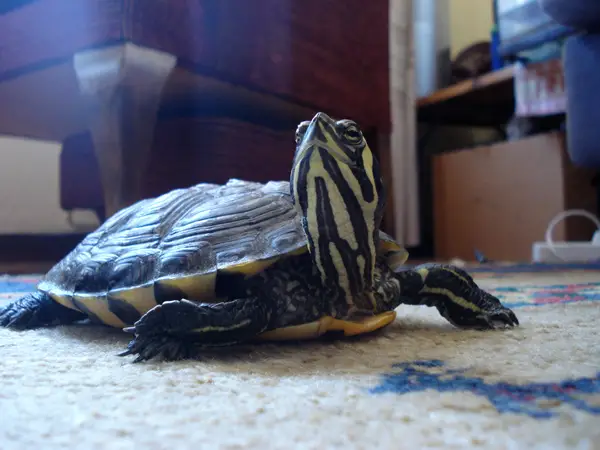
- Scientific name: Trachemys scripta scripta
- Common name: Yellow-bellied slider
- Family: Emydidae
- Size: 8 to 13 inches (females), 5 to 9 inches (males)
- Lifespan: 30 to 40 years
- Conservation status: Least Concern
The yellow-bellied slider turtle is a sub-species of pond sliders native to the Southern region of the United States, including Mississippi.
It is a semi-aquatic turtle that lives in water as well as land. And it can be found in a variety of habitats including floodplain swamps slow-moving rivers, seasonal wetlands, marshes, and even permanent ponds.
As the name suggests, this turtle features a yellowish plastron. Plus, it bears yellowish markings on its skin, not to forget prominent yellow stripes behind its eyes. The upper shell color ranges from dark brown to olive.
These Mississippi sliders are omnivorous and like eating fish, snails, insects, and aquatic vegetation. they also eat land vegetation, including fruits and vegetables.
It is also worth noting that Mississippi Yellow-bellied sliders are a popular choice of pet turtles for most folks. They don’t require a lot of special care, which makes them a favorite for many folks.
26. Green Sea Turtle
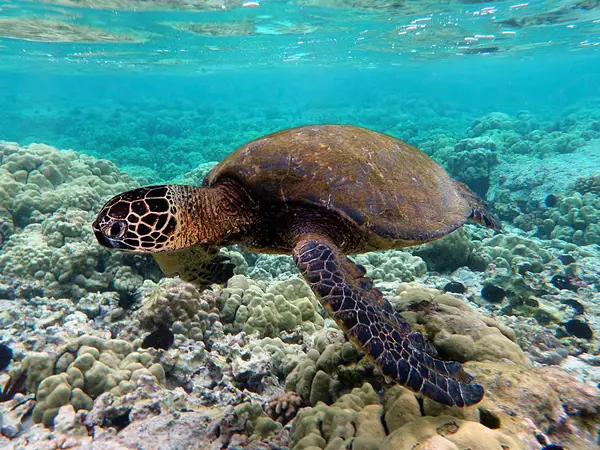
- Scientific name: Chelonia mydas
- Common name: Green turtle, Pacific green turtle, Black sea turtle
- Family: Cheloniidae
- Size: 2 to 5 feet
- Lifespan: 60 to 70 years
- Conservation status: Endangered
The green sea turtle species is classified among the largest hard-shelled sea turtles in Mississippi. It can reach up to 4 feet in length and weighs up to 400lbs.
This species is characterized by scutes that run down the middle; they’re 4 on each side. The shell color can be gray, dark brown, or olive with a yellow-to-white bottom shell or plastron.
It also features a serrated beak on its lower jaw and two large scales resign between the eyes.
Males are generally larger than females and have longer tails. The females lay their eggs on the beach and use their paddle-shaped flippers to easily burrow in the sand when laying eggs. A single green turtle can lay up to 200 eggs!
This Mississippi sea turtle species gets its name from its primary diet which consists of age and seagrasses (mind you, this diet is responsible for tinting its cartilage green).
Green turtles in Mississippi are usually found in tropical as well as subtropical waters throughout the years. They also tend to migrate to cooler temperatures and even boreal waters when the weather gets warmer.
27. Hawksbill Sea Turtle
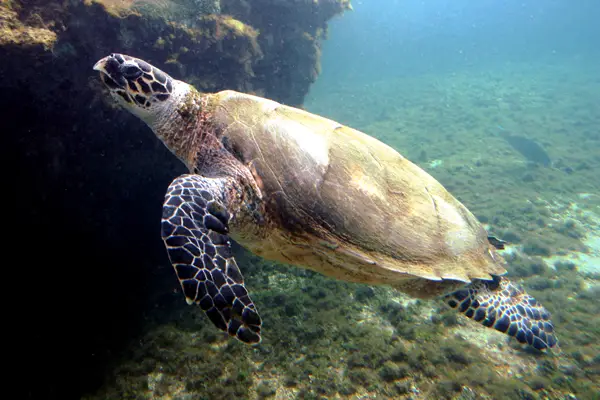
- Scientific name: Eretmochelys imbricata
- Common name: hawksbill turtle
- Family: Cheloniidae
- Size: 2.5 to 3 feet
- Lifespan: 50 to 60 years
- Conservation status: Critically endangered
Hawksbill sea turtles have been found in Mississippi in shallow coastal areas or tropical, or rocky waters. It can also be spotted in the reefs and estuaries.
The adult has an average size of 3 feet and weighs around 180 pounds. The shell of this turtle features an amber carapace with irregular light and dark streaks. They also feature predominant black and molten-brown easily radiating to the sides.
The shell tends to change color depending on the water temperatures.
This colored and patterned shell makes this turtle highly valuable and is commonly sold as “tortoiseshell” in the markets.
The hawkbill turtle is so named due to its narrow, pointed beak. It also has a distinctive pattern of overlapping scales on its shells which form a serrated look on the edges.
These turtles mainly feed on the sponge which they easily extract from reef crevices with the help of their narrow, pointed beaks. They also feed on jellyfish.
Hawkbill turtles are generally found in tropical oceans throughout the world. While they live in the open ocean, they tend to spend more time in coral reefs and shallow lagoons in Mississippi.
During nesting, a female hawkbill turtle will look for small coves, “pocket” beaches, or inlets surrounded by rocks. They tend to travel high up the beach to lay eggs in shelters formed by the plants.
28. Kemp’s Ridley Sea Turtle
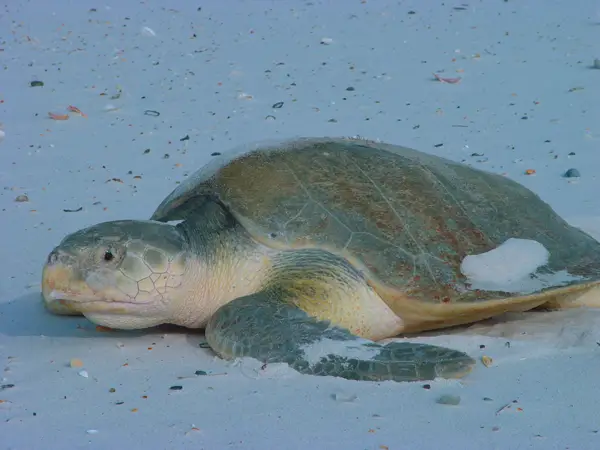
- Scientific name: Lepidochelys kempi
- Common name: Atlantic ridley sea turtle,
- Family: Cheloniidae
- Size: 2+ feet
- Lifespan: 30+ years
- Conservation status: Critically endangered
Kemp’s ridley sea turtle is the smallest species of all the sea turtles in Mississippi. The average adult size is about 2 feet and weighs approx. 110 lbs. They have adapted flippers (front limbs) and a beak.
This turtle is the rarest sea turtle species and is one of the world’s most endangered species. The species is called Kemp’s ridley because Richard Moore Kemp of Key West was the first to send its specimen to Samuel Garman at Harvard university. However, the origin of the name ridley is still unclear.
Note that these turtles tend to change their color as they age. Baby turtles feature dark purple color along the sides which turns into yellow-green as they mature.
Kemp Ridley is also the only sea turtle that nests during the day.
These Mississippi turtles also practice Arribada nesting, which involves all the females nesting together in a tight group. This helps them protect themselves better from predators as well as help their hatchlings easily make it to the open ocean.
29. Leatherback Turtle
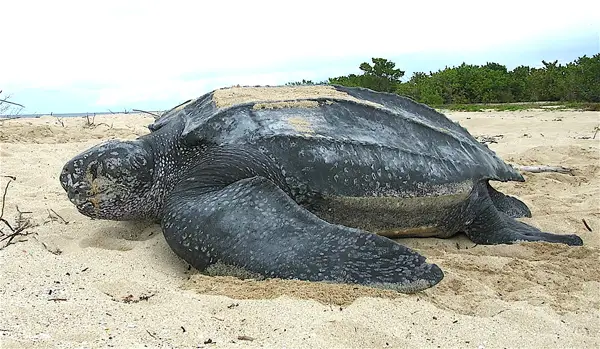
- Scientific name: Dermochelys coriacea
- Common name: leathery turtle, trunk turtle, Lute turtle, luth
- Family: Dermochelyidae
- Size: 5 to 6 feet
- Lifespan: 50+ years
- Conservation status: Vulnerable
The leatherback sea turtles are found in Mississippi state and are known to grow to mammoth sizes (up to 6 feet!). An average adult can also weigh as heavy as 540lbs!
Leatherback turtles usually have black shells. And they differ from other species of turtles with their smooth leathery carapace and skin. Their upper shell is made up of a flexible layer of dermal bones covered by tough and oily connective tissue and smooth skin.
The body of this turtle is barrel-shaped and then tapered to the rear. They have a total of 7 longitudinal dorsal ridges and their whole body is almost completely black, with some variable spotting.
Leatherback turtles in Mississippi have tooth-like cusps that work closely with their sharp-edged jaws to enable them to easily feed on jellyfish, salps, and other gelatinous zooplankton.
As for the habitat, these turtles of Mississippi are fond of tropical and subtropical waters all year round. But they tend to migrate to cooler, temperate, and boreal waters during warm weather.
Note that this species is highly migratory and can swim as many as 10,000 miles in a year between foraging and nesting grounds. They’re also excellent divers—with the deepest diving record standing at whopping 4,000 feet!
30. Loggerhead Sea Turtle
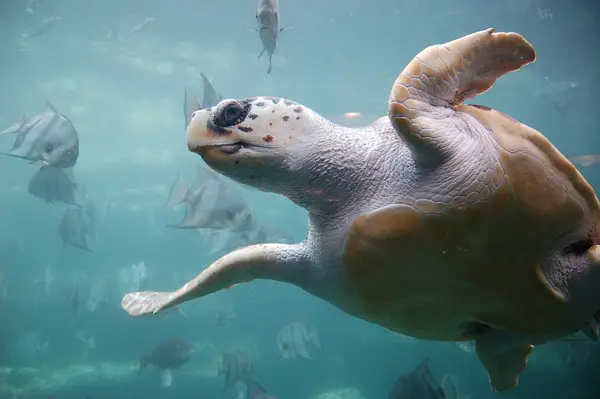
- Scientific name: Caretta caretta
- Common name: Loggerhead, Loggerhead Sea-Turtle
- Family: Cheloniidae
- Size: 3.5 feet
- Lifespan: 70+ years
- Conservation status: Endangered
Loggerhead sea turtles boast their place as the most abundant sea turtle species in the United States and are found in many states, including Mississippi.
These turtles are pretty big and can reach up to 3.5ft in length. They weigh up to 350 pounds and can live for a whopping 70 years or more.
A loggerhead is distinguished by a slightly heart-shaped carapace that’s reddish brown in color, with pale yellow plastron. Some species also feature yellow-bordered scutes.
This turtle species of Mississippi gets its name from its large head. It has powerful jaws that enable it to feed on a variety of foods including conch, whelks, insects, jellyfish, gastropods, and algae.
The loggerhead turtles in Mississippi are usually found in temperate, tropical, and subtropical waters all year round. However, they also tend to migrate to cold boreal waters on rare occasions.
31. Eastern Box turtle
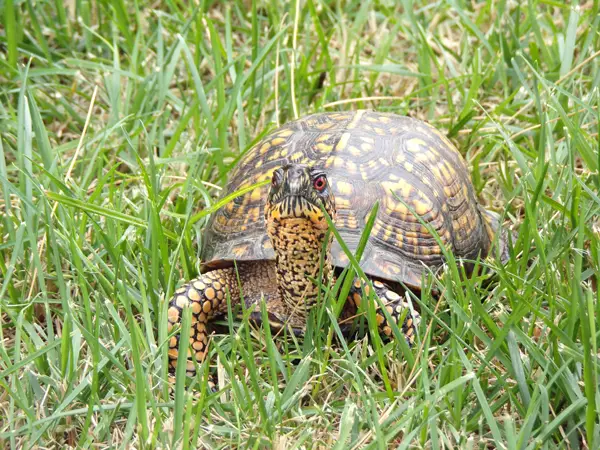
- Scientific name: Terrapene carolina carolina
- Common name: Eastern Box Turtle, Land turtle, Box Turtle
- Family: Emydidae
- Size: 4.5 and 7 inches
- Lifespan: 50 to 100 years
- Conservation status: Vulnerable
The eastern box turtles of Mississippi are found in dense thickets and woodland areas. They prefer these areas due to abundant access to sunlight and food sources nearby.
An adult turtle of this species is about 4.5 to 7 inches and weighs just 2lbs. It has a high, domed shell shape with a ridge running from head to toe. The shell of this turtle has varying colors of olive, brown, and tan.
The variation in markings on the shells of these turtles is so variable that you can’t easily recognize one by looking at the shell alone.
These eastern box turtles of Mississippi are omnivorous and feed on a variety of foods including insects, meat, fruits, vegetables, and various types of vegetation.
Note that eastern box turtles are taken from the Mississippi wild for pet trade, leading to a decline in their population. For this reason, many states have illegalized capturing and selling of this species.
And those in captivity end up dying due to poor conditions or being abandoned or released back into the wild because they’re too demanding to maintain.
32. Gulf Coast Box Turtle
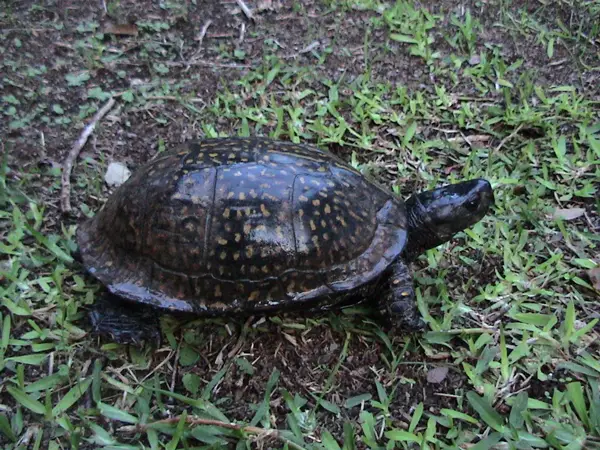
- Scientific name: Terrapene carolina major
- Common name: Gulf Coast box turtle
- Family: Emydidae
- Size: 6 to 8.5 inches
- Lifespan: 30 to 40 years
- Conservation status: Not extinct
The gulf coast box turtle is the largest of all the common box turtle subspecies. The turtle prefers living near Mississippi brackish waters, swamps, and estuaries.
It likes warm and humid conditions.
Gulf coast box turtle in Mississippi has a dark brown or black shell with a fluted edge and yellow stripes or dots.
As for the skin, it is much darker than other box turtle species and ranges from black to dark brown.
This Mississippi box gulf coast box turtle is omnivorous. And its diet is mainly made up of insects, amphibians, and mollusks. It also occasionally feeds on plant matter for a balanced diet.
Similar to the eastern box turtle above, this turtle also makes a good choice for a pet turtle.
33. Three-toed Box Turtle
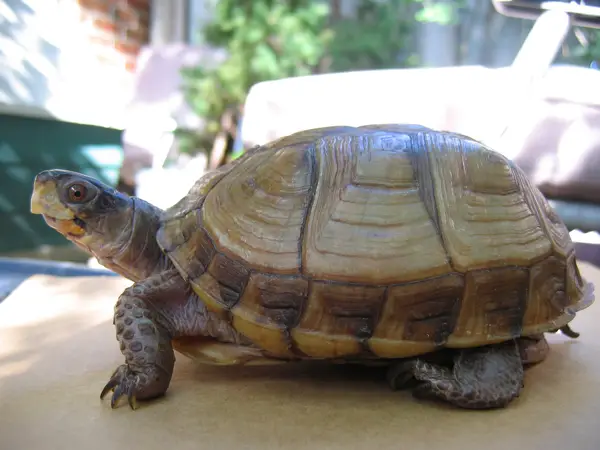
- Scientific name: Terrapene triunguis
- Common name: N/A
- Family: Emydidae
- Size: 4.5 to 5 inches
- Lifespan: 50 and 100 years
- Conservation status: Vulnerable
The three-toed box turtles inhabit the thickets, prairies, and woodlands of Southwest Mississippi. They’re easily identifiable by the 3 toes on their hind limbs, unlike the usual 4 toes on other box turtle species.
They have a uniform olive to brown shell color, sometimes with light spots or streaks. Bright yellow or orange spots are also occasionally spotted on the turtle species’ head and leg.
A mature three-toed box turtle has an average size of 4.5 to 5 inches.
They are unlike other box turtles in that they’re the only species that will remain healthy if you have them in indoor enclosures.
Being omnivorous in nature, these Mississippi turtles are known to eat snails, insects, earthworms, slugs, mushrooms, strawberries, and green-leafed vegetation. They have also been spotted eating quail eggs.
34. Gopher Tortoise

- Scientific name: Gopherus polyphemus
- Common name: Gopher
- Family: Testudinidae
- Size: 6 to 9.5 inches
- Lifespan: 40 to 60 years
- Conservation status: Vulnerable
Gopher is a fairly large tortoise and the ONLY tortoise inhabitant of Mississippi land. An adult has a size of 6 to 9.5 inches. They have brown or tan shell color and grayish-brown skin with yellow or orange botches.
The terrestrial reptile has its forefeet well adapted for burrowing. The front legs are scaly and shovel-like to allow for easy digging.
Mind you, this turtle gets its name from its ability to dig deep burrows—just like a gopher the rodent!
Even more interesting is that these burrows provide shelter to 360 other animals in Mississippi, including frogs, owls, engendered indigo snakes, etc.—making the tortoise a keystone species.
They mainly feed on vegetation such as mushrooms, grass, flowers, apples, and berries. Since they’re omnivorous in nature, they also feed on dead crabs or insects they come across.
Gopher tortoises tend to be more active during warmer weather. Their burrows can maintain more constant temperatures, making them safe havens for them.
NOTE that it is illegal to domesticate a gopher tortoise as a pet in Mississippi. They also face the threat of a declining population mainly caused by human interference.
Mississippi authorities limit land development in areas with these tortoises or their burrows. It is also illegal to relocate these species without permission from Fish and Wildlife Services.
Related: Turtles in Delaware
Conclusion
Mississippi is one of the top US states with diverse turtle species ranging from semi-aquatic to aquatic, terrestrial turtles, tortoise species, and sea species.
Freshwater/aquatic turtles make the largest group of species found in Mississippi and include the snapping turtles, smooth softshells, spiny softshells, pond sliders, Cooters, painted turtles, map turtles, mud and musk turtles, chicken turtles, and diamondback terrapins.
Most of these freshwater turtles prefer living in Mississippi’s large river systems such as Pearl, Pascagoula, and Mississippi Rivers.
Terrestrial turtle species are concentrated in the state’s woodlands and grasslands. And the sea turtles are mainly found on Mississippi’s coastlines.
